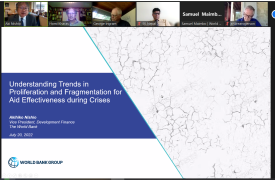This roundtable discussed aid effectiveness, proliferation, and fragmentation in light of the newly published World Bank report: Understanding Trends in Proliferation and Fragmentation for Aid Effectiveness During Crises. World Bank Vice President for Development Finance, Aki Nishio, presented key findings of the report, followed by a panel and open discussion, moderated by Senior Fellow Homi Kharas and attended by a variety of participants from Brookings, the World Bank, nonprofits, and academia. Panelists included: Shreekrishna Nepal – Secretary for the Ministry of Social Development in Nepal Belinda Archibong – David M.
Rubenstein Fellow at Brookings and assistant professor of economics at Barnard College, Columbia University Andrew Rogerson – Senior Research Associate at ODI Over the last two decades, the increase in Official Financial Flows (OFF) from developed countries to developing countries has been accompanied by an increase in donors and donor agencies. The number of donor agencies nearly tripled from 194 in the period 2000-2004 to 502 in the period 2015-2019. This proliferation is felt by recipient countries, many of whom now have more than 60 donor entities to manage.
Additionally, a greater share (three out of four) of OFF funded projects are being implemented by entities other than the recipient governments, such as the donor government, private sector institutions, multilateral organizations, and others. At the same time, the size of individual donations has decreased, with the average size of Official Development Assistance grants being roughly cut in half from 2000 to 2019. Collectively, these trends raise concerns around aid effectiveness and transaction costs for recipient countries.
Mr. Nepal confirmed the greater workloads and difficulties that may result from relying on a multitude of donors. He expressed the challenge of obtaining funding for broad budget support, as opposed to earmarked project support.
Donors increasingly want to fund projects where they can “stake their flag” and receive credit, leaving fewer funds to the discretion of recipient countries on how they will be used. Archibong commented on the potential consequences of fragmented health aid, for example, during public health crises when liquidity is necessary. Rogerson posed various questions surrounding the ideal aid infrastructure and discussed the use of cash transfers for social protection in crises.
By publishing this report, Nishio hopes to get the issue of aid effectiveness, proliferation, and fragmentation back on the international agenda after about 10 years since the last global forum at Busan. Pooled funding has been widely acknowledged as a solution to these issues, but adoption has been low. It is also worth noting that the trends have not been as present for multilateral channels of aid as bilateral, leading discussants to encourage greater use of channels like IDA.
There was an acknowledgement by participants that a diversity of donors has certain benefits, particularly for funding innovation, and that these trends mask a great diversity of country outcomes. The participants discussed how future work could use country case studies to better understand the impact of aid proliferation and fragmentation on recipient countries. > View full list of roundtable participants.
From: brookings
URL: https://www.brookings.edu/events/roundtable-discussion-on-understanding-trends-in-proliferation-and-fragmentation-for-aid-effectiveness-during-crises/



